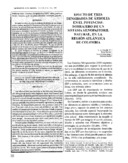Efecto de tres densidades de árboles en el potencial forrajero de un sistema silvopastorial natural, en la región atlántica de Colombia
Alternative title
Effect of three tree densities on the forage potential of a natural silvopastoral system in the Atlantic Region of Colombia
Description
1 ilus. 7 tab. 15 ref.
Abstract
Se midió el efecto de tres densidades de árboles en los componentes sombra, cantidad de biomasa y calidad del forraje que provee el pasto de guinea (Panicum Maximum) y los árboles, así como el aporte de nutrimentos al suelo, a través del reciclaje proveniente de la hojarasca, las ramas y los frutos. El estudio se efectuó al norte de Colombia, en casi 15 ha dedicadas a sistemas silvopastoriles.El aporte de proteína de los árboles no varió por la densidad, pero fue alto con la leguminosa (Calliandra Calothyrsus)Meiss., con valores mayores al 15%, durante el verano. La leguminosa mostró un mayor potencial forrajero. The effect of three tree densities of the following components of a silvopastoral system were measured: shade, total biomass and forage quality of both trees and Panicum Maximum pasture, nutrients supplied to the soil through recicling of leaves, fruits and branches. The study was carried of in an area of almost 15 ha of silvopastoral systems established of processes of natural regeneration, in northen Colombia. The protein contribution of the trees did no vary with tree density but was highest with the leguminous tree, Calliandra Calothyrsus Meiss., which had in protein contents greater than 15% in the dry season. This woody legume showed the greatest forrage potential in the silvopastoral systems.
Keywords
Publisher
CATIE, Turrialba (Costa Rica)


